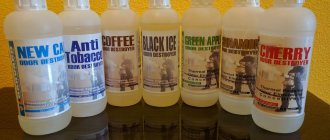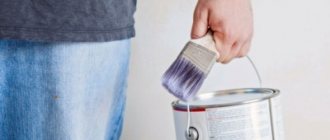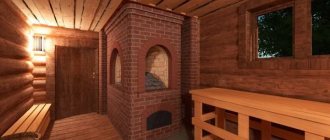With the onset of autumn, gray spots may form on the surfaces of ceilings and walls in a private house. They indicate the presence of dampness. Rooms are ventilated less often, and the amount of precipitation increases. The material from which the building structure was erected does not dry out completely. The presence of excess moisture is a serious problem. It is necessary to wage a decisive fight against it. This situation can lead to various diseases. The structure will begin to gradually collapse. In order to understand how to get rid of dampness in the house, you need to understand the reasons for its appearance. Only then will it be possible to find effective ways to combat this unpleasant phenomenon.
Negative effects of dampness in the apartment
According to standards for residential premises, the permissible level of relative humidity is 40-60%. If the moisture content in the air becomes higher, it can negatively impact the quality of life in the home.
First of all, the harm that dampness causes to people living in the room is taken into account. In humid air, fungi, mold spores and other pathogenic microorganisms rapidly spread and enter the human body through the lungs and skin. Even if they do not cause specific diseases, they worsen overall health:
- Colds become more frequent and more severe.
- Allergic manifestations intensify.
- Painful weakness occurs.
- Performance deteriorates.
An unfavorable atmosphere is created in the room. There is a specific smell of dampness that eats into clothes and furniture. The shelf life of food products, especially bread, cereals, and flour, is reduced.
Almost the entire housing environment suffers:
- Door frames and floor coverings are deformed.
- Spots from mold and mildew appear on the walls.
- The wallpaper swells and comes off the walls.
- Clothes and bedding in the closet acquire a musty smell.
- Leather and wood products, books become damp and become unusable.
How to reduce humidity in the house?
- It is necessary to carry out waterproofing work on the house . If you have a basement, it should be addressed first, as it is often the main cause of increased humidity in the house as a result of changes in groundwater levels. You can get rid of moisture in the basement using dry construction mixtures, the main component of which is concrete. Then we move on to waterproofing the house itself. For this purpose, it will be necessary to finish the outer surface of the walls by applying several layers of plaster to them. Don’t forget about the roof of the house, because moisture also penetrates through it, and this can be felt especially strongly in autumn and spring. It can be protected with waterproofing material, which is mounted on the inside of the roof.
- Now you need to waterproof the inside of the house. For this, it is best to use drywall, since it has one feature that distinguishes this material from other similar ones: if the house is damp, it is able to absorb excess moisture. In the same case, if the humidity in the room is reduced as a result, for example, of the heating system of the house, the drywall begins to release moisture.
- But they will not be able to finish the walls in the most problematic room of the house - the bathroom. It is from there that dampness spreads throughout the house. Here it will be necessary to carry out waterproofing using a material such as liquid glass, which will get rid of dampness. If you are not sure that you can do all of the above yourself, it is better not to try, but hire specialists, since the final effect will depend on the quality of this work. Whether you live in a dry, warm house or in a house in which there is constant dampness, as a result of which mold and mildew appear on the walls, is entirely up to you. It's better to spend money once than to suffer all your life.
Where does dampness come from in an apartment and private house?
The most common reason for dampness in an apartment is poor ventilation or its absence. Possible reasons:
- The ventilation hole is covered with wallpaper.
- The air path is blocked by furniture standing close to the walls.
- During the installation of kitchen equipment, the ventilation ducts were installed unsuccessfully.
Often the source of moisture is in the bathroom. By inspecting this room, you can begin your search for excess water at home.
- If there are leaks on the ceiling or walls, your upstairs neighbors may be flooding you.
- Moisture on the floor indicates faulty water or sewer pipes. If they are sewn into a box, this makes it difficult to immediately notice the leak.
- Laundry hung out to dry evaporates a lot of moisture in the small bathroom space.
There can be many reasons for dampness in an apartment, and they must be dealt with systematically. Some of them depend on the design of the entire house and its condition. In multi-storey buildings, the management company is contacted in the following cases:
- basement flooding;
- leaking roof;
- poorly sealed seams in the walls;
- improper thermal insulation of walls and floors.
In a private house there are other problem areas for which the homeowner himself is responsible. These are poorly located drains, when water gets on the base near the wall, or closed cesspools located next to the house - septic tanks, if their tightness is broken.
The humidity in the house is affected by the climate of the lower floors. Groundwater that has penetrated into the basement, and even a swimming pool or sauna located on the ground floor, have a negative impact.
Causes of dampness in the house
Of course, the air in an apartment cannot and should not be too dry. The normal humidity level is a maximum of 60%. It can be measured using a special device - a hygrometer. This is the optimal value at which everyone living will feel good. But it happens that the house becomes too damp, this causes the appearance of fungus, mold and other unpleasant and dangerous phenomena. Why is this happening? There are several reasons:
- Incorrect ventilation design.
- Problems with the roof.
- Disturbed technology when laying the foundation.
- Errors in plumbing installation.
- Cracks in the walls.
Fighting dampness
It is possible and necessary to take measures to reduce the content of water vapor in the air. This is not only an improvement in living conditions, but also a concern for health. Both the house itself and the things in it will remain safe and usable for a long time in a dry atmosphere.
Eliminating the causes of dampness on the first floors
For residents of the first floors, the main reason for dampness in the apartment is the constantly flooded basement. Utility services must deal with such emergencies. If they cannot cope with this, or the defects lie in the foundation of the house, residents have to solve the problem themselves.
It helps to install a coating or adhesive waterproofing of the floor using waterproofing plasters. At the same time, you can achieve high-quality insulation of the ceiling in the basement.
On the upper floors
The problem area for apartments on the upper floors is the roof. A flat roof without slopes often leaks. Waterproofing the ceiling will not help here, since the moisture will simply go into the walls. It is better to insulate the floor in the attic or technical floor.
In a private house
A private home is exposed to moisture from literally all sides. To create a comfortable environment in it, first of all you need to take care of installing the correct drainage system on the site. This will help lower the groundwater level and reduce the risk of a damp basement.
Much attention should be paid to the external and internal waterproofing of the foundation and plinth.
Finally, the condition of your roof and gutters directly affects dampness in your home. On all floors, moisture penetrates the walls due to poorly sealed interpanel seams. This construction defect can only be corrected with the help of professional repairmen.
Actions that every person can take at home: dry clothes on the balcony or purchase a washing machine with a drying function, as well as turn on heating and air-drying appliances in a timely manner.
Installation of forced ventilation and frequent ventilation
Synthetic finishing materials and sealed double-glazed windows disrupt the natural air circulation in the apartment. Moisture accumulates indoors with no way out. On the upper floors, residents also suffer from poor draft in ventilation shafts.
Ventilation helps a lot in this situation, but in the cold season it is impossible to keep the windows open all the time. It is recommended to integrate modern ventilation mechanisms into plastic windows, for example, the so-called alpine window.
This device is capable of ensuring the exchange of indoor and outdoor air when the windows are closed.
Another useful device is humidified grilles, which are installed in ventilation ducts to regulate the draft air flow depending on humidity.
Installing forced exhaust ventilation requires effort and financial costs. But it completely solves the problem of removing humid air from the apartment. Such ventilation consumes electricity and is slightly noisy, but its benefits are great. The minimum option for forced ventilation is to install an electric fan in the kitchen ventilation duct.
Recuperators are built into exhaust systems. In them, the cold air coming from the street is heated in the process of heat exchange with the exhaust air, which is already warm and comes from the apartment. This device helps save energy for heating the room.
Additional heating and thermal insulation
The air in a heated room feels drier. Additional heating of an apartment is an effective and generally accessible way to combat dampness. Any source is suitable for heating: sunlight, heated floors, air conditioning with heating or an oil radiator. An electric heated towel rail will help create a dry atmosphere in the bathroom. Additional heating devices will easily dry the air in the room and rid it of the musty smell.
If moisture has already been absorbed into the floor and walls, you need to warm it up longer using powerful devices. Sometimes, despite drying, repairs are inevitable.
You can do without heating or make it less intense with the help of proper thermal insulation of the walls. Thermal engineering calculations show that a thickness of 100-150 mm of extruded polystyrene foam insulation will provide sufficient insulation for any wall.
The second option for effective thermal insulation is a vapor-permeable insulation, for example, mineral wool or a ventilated facade.
Repair as a means of combating dampness and odor
For a very damp room, drying alone is not enough. Mold and mildew deeply affect the walls, and repairs cannot be avoided.
For modern renovations, try to choose natural finishing materials. They are vapor permeable and remove moisture from the room to the outside.
- If the cause of moisture is flaws in the building's design, the walls need to be insulated not only from the inside, but also from the outside, and the seams at the joints of the panels must be sealed.
- In potentially damp rooms, grouts and plasters with antifungal additives are used.
- The walls are treated with anti-mold agents and then plastered again.
- Severely damaged or deformed floors are replaced with new ones.
If possible, avoid plastic windows or equip them with modern ventilation devices. It is better to place furniture at some distance from the walls so that it does not block the air flow to the ventilation holes.
Devices - dehumidifiers
Technical means designed to remove moisture from the air are widely used. For a kitchen or room, it is enough to purchase a dehumidifier with a capacity of 10 liters per day. If the device has a built-in humidity sensor, it will be able to adapt itself to changing external conditions.
This dehumidifier automatically monitors the state of the atmosphere and regulates the humidity in the room. The air will not dry out and excess electricity will not be consumed.
It is convenient to have a portable dehumidifier so that you can use it alternately in different places.
The air in the bathroom is well dried with a heated towel rail if there are no constantly wet towels hanging on it. Air conditioning also successfully reduces humidity levels. Finally, heating devices are indispensable in the fight for drying. Increasing their usable surface and properly adjusting the heat supply have a beneficial effect on the climate in the apartment.
Use of kitchen hoods
When cooking food, liquids evaporate intensely into the air. Therefore, the kitchen is one of the wettest rooms in the apartment. Usually there is a ventilation duct in the kitchen. But without the use of forced ventilation, its power may not be enough.
Therefore, electric kitchen hoods are built above the stove, which direct the fumes into the ventilation. The power of the device must correspond to the amount of evaporation and the size of the room. For a kitchen where food for the whole family is prepared daily, a hood with a capacity of 500 m³/hour will be sufficient.
Watch the video about the causes of dampness in rooms and methods to combat it.
Reasons for rising humidity
Dampness can appear in the house in two ways.
Infiltrate from outside
If there was a defect during construction work, moisture will likely appear in the house soon. Damp in the house may be due to the fact that the groundwater level has risen or, if the house is panel, water may seep through the joints.
Form inside
First of all, it is condensation. Dampness appears if the rooms are rarely ventilated or work is often carried out that causes an increase in humidity, for example, cooking or washing, if the room is poorly insulated, if pipes are leaking in the bathroom and in the ceilings between floors, or if there is a lot of various plants or aquarium there.
How to get rid of dampness using folk remedies
Housewives have always tried to create a healthy atmosphere in the house. Therefore, there are many simple ways to get rid of damp that are suitable for any home.
Cleaning products
If there is an excess of humidity in the room, all surfaces should be wiped dry after wet cleaning. This especially applies to floors. After cleaning the furniture from dust, it is recommended to wipe it with a light pink solution of potassium permanganate. After cleaning the room, you need to ventilate it well.
Those places where mold has managed to grow are wiped with a rag soaked in a solution of bleach or vinegar. You can also spray the surface with a solution from a spray bottle. Bleach makes even damp corners unsuitable for fungi. Vinegar, which is essentially a weak acid, also works. In addition, these substances kill the musty smell, and after ventilation the air becomes fresh.
Sorbents: salt, sugar, coffee
An old-fashioned way to remove dampness from any room is to place substances there that absorb moisture from the air. The most popular and always on hand are sorbents such as coffee beans, salt, and sugar. Poured into breathable bags, they are placed in different places. In the wardrobe, these products are laid out on shelves in fabric bags, and open jars are placed in the pantry. These moisture traps will help dry out your apartment.
Silica gel
A modern moisture absorber is silica gel. It is produced in the form of transparent granules with a diameter of 2-6 mm. The porous structure of their surface allows them to absorb large amounts of water vapor from the air. Most types of silica gel are environmentally friendly and non-toxic.
This sorbent is poured into a tray or packed into small bags, which are placed in problem areas. The silica gel, saturated with moisture, is reactivated by heating it to a temperature of 100-150°C.
Houseplants that don't like moisture
Tropical plants require frequent watering and spraying. Such a home greenhouse can negate all efforts to drain the apartment. The evaporation from the pots and from the surface of the leaves is quite intense. It is recommended to choose drought-resistant plants that do not need to be watered abundantly.
Also, in damp rooms you should not install aquariums, decorative fountains and other devices associated with water evaporation.
Maintaining humidity at a comfortable level is of great importance for human health. Clean, dry air helps keep the building and the furnishings in the apartment in good condition. Considering the variety of means to combat dampness, everyone can choose the most suitable and effective ones. It will take some effort, but the right climate in your home is worth it.
Other ways to get rid of dampness
These two methods are the most radical, but also the most effective , so don’t skimp, waterproof the house and provide good ventilation. However, if you don’t want to spend so much money, you can use these methods to get rid of dampness in your home:
- Frequent ventilation . With regular ventilation, the humidity in the house will decrease, since damp air will leave the room. The kitchen must be ventilated after cooking, and during cooking the window must be open or the ventilation turned on. Dampness occurs as a result of condensation that forms when liquid boils in an open pot or pan. Ventilate the bathroom after washing and water procedures, since steam from hot water is also a source of condensation, which settles on the walls of the room, which can cause the rapid appearance of fungus or mold, which will not be so easy to get rid of.
- Try not to dry clothes in the house . Or, if there is no other way out, because it’s pouring rain outside, for example, hang it in a room with a good ventilation system. But the best thing for you would be to buy a special drying cabinet. In addition, you will have to abandon the washing vacuum cleaner.
- Do not close the windows with curtains in summer, as the sun dries out the room quickly enough.
- Air conditioners and hoods will relieve you of dampness in your home . These devices are able to absorb excess moisture in the air, lowering its level to an acceptable value and thus protecting the house from the appearance of fungus and mold, the room remains dry and warm all the time.
- To get rid of dampness, ordinary desiccant tablets, which can be purchased at any hardware store, may be quite sufficient.
- You can also use calcium chloride in powder form. It must be poured into an open container and placed in a place where there is high humidity, that is, in a room with poor ventilation. The powder absorbs moisture, after which it is enough to dry it, evaporating all the moisture from it, and can be used again.
- To get rid of dampness in your home, you can purchase a special device such as a dehumidifier . Thanks to its mobility, this device can be used throughout the house, including in the bathroom. However, you should only buy it if you are planning to dry a room that is very difficult to ventilate or there is no normal ventilation system, because the results that you will achieve in the process of operating the dehumidifier for two hours can be obtained with just ten minutes of ventilation. And it turns out that you wasted your money and time on buying this dehumidifier, since there is no benefit from it in such a situation.











